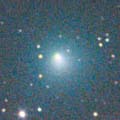
|
The Deep Impact mission succeeded on July 4. It had kept bright at 10 mag for two months since May until the impact, while getting diffused gradually. The central nucleus shining just after the impact was observed even on the ground. Mike Linnolt confirmed that the degree of condensation (DC) increased from 4 to 8 during 30 minutes. But the total magnitude brightened by only 0.5 mag. The nuclear magnitude brightened by 1-2 mag. The change was temporary. The comet almost returned to be the original state on the next day. Because the influence to the comet was very small, it will be fading as predicted. The condition keeps good in the Southern Hemisphere. However, it will be very low in the evening with an altitude of aroud 17 degree after this until December in the Northern Hemisphere. Only a few observations have been reported after the Deep Impact. It was 10.9 mag on Aug. 5 (Seiichi Yoshida), it started fading as expected.
Date(TT) R.A. (2000) Decl. Delta r Elong. m1 Best Time(A, h)
Aug. 20 15 29.46 -25 30.3 1.218 1.574 89 11.4 18:56 (113, 70)
Aug. 27 15 49.69 -27 11.1 1.281 1.595 87 11.6 19:01 (105, 69)
|
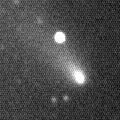
|
Although it was faint as 15.2 mag on Mar. 14 (Yuji Ohshima), it brightened in April, and finally it became bright enough to be visible visually, 12.3 mag on May 2 (Juan Jose Gonzalez). Then comet kept brightening and reached to 9.2 mag (July 2, Carlos Labordena). Although it became brightest about 2 weeks before the perihelion passage in its last appearance in 1998, it kept brightening until the perihelion passage in this return. However, only a few observations have been reported because it locates very low in the morning. It is already fading, and now it is 10.4 mag (Aug. 5, Seiichi Yoshida). The altitude will be higher than 30 degree after October, when the comet will be already fainter than 13 mag.
Date(TT) R.A. (2000) Decl. Delta r Elong. m1 Best Time(A, h)
Aug. 20 6 28.93 6 23.7 1.575 1.234 51 11.4 5:10 (240, 26)
Aug. 27 6 48.96 3 52.3 1.603 1.287 53 11.8 5:01 (242, 28)
|
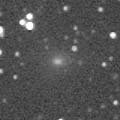
|
Although it was reported as 14 mag by CCD observations, actually it was bright as 12.4 mag visually (July 8, Juan Jose Gonzalez). Then it brightened a bit, and now it is 11.4 mag (Aug. 15, Juan Jose Gonzalez). Because it moves in the northern sky, it is not observable in the Southern Hemisphere until when it becomes faint. In the Northern Hemisphere, it will be getting lower and lower in the morning sky. It keeps 12 mag until September, but the altitude will be lower, down to 10 degree in September. Then it will be higher gradually, however, it will be fainter than 14.5 mag when the altitude becomes higher than 30 degree.
Date(TT) R.A. (2000) Decl. Delta r Elong. m1 Best Time(A, h)
Aug. 20 8 34.71 51 7.2 1.651 1.126 42 11.6 5:10 (222,-22)
Aug. 27 9 22.07 48 28.9 1.689 1.129 40 11.7 5:01 (227,-25)
|

|
It will reach to 9 mag in 2006 spring. It had been brightening well as expected until 2005 March. It was 15.1 mag on Mar. 5 (Mitsunori Tsumura). Then it had been too low for a while, however, now it locates high again in the Southern Hemisphere. It brightened up to 13.9 mag on Aug. 1 (Michael Mattiazzo). In the Southern Hemisphere, it keeps observable for a long time after this. In the Northern Hemisphere, it is not observable until 2006 March, except it appears very low in the morning at 12 mag from late August to early September. After 2006 March, northern people can observe it for a long time while it is getting fainter.
Date(TT) R.A. (2000) Decl. Delta r Elong. m1 Best Time(A, h)
Aug. 20 5 47.39 -31 28.8 2.822 2.725 74 12.1 5:10 (276, 56)
Aug. 27 5 53.11 -34 41.7 2.682 2.659 77 11.9 5:01 (280, 59)
|

|
In January when it was visible in the Northern Hemisphere, it was an 11 mag small object. However, after it has gone to the southern sky, it brightened rapidly and reached to 8.0 mag from March to April (Mar. 4 and Apr. 7, Alexandre Amorim). After the perihelion passage on Apr. 10, it turned to be fading slowly, 8.9 mag on May 12 (Michael Mattiazzo) and 10-10.5 mag on May 31 (Terry Lovejoy). It is bright as 12.1 mag still now (Aug. 15, Juan Jose Gonzalez). In the Northern Hesmisphere. It keeps observable in good condition while fading gradually. The split of the nucleus was found on June 25. The secondary nucleus was fainter than the primary by 0.7 mag, so both nucleus can be detected on CCD images. No effect of the split was found on the total brightness of the comet.
Date(TT) R.A. (2000) Decl. Delta r Elong. m1 Best Time(A, h)
Aug. 20 0 45.97 26 15.7 1.564 2.284 123 12.0 2:54 (180, 29)
Aug. 27 0 27.42 27 50.9 1.578 2.372 131 12.2 2:08 (180, 27)
|

|
It was 14 mag on May 12 when appearing in the morning low sky (Michael Mattiazzo). Then it has been brightening as expected, and it was 11.3 mag in mid June around the perihelion passage (June 16, Juan Jose Gonzalez). In its last appearance, the comet unexpectedly brightened after the perihelion passage, and reached to the maximum brightness about 45 days after the perihelion passage. In this return, it continued brightening even after the perihelion passage again, and reached to 10.2 mag on July 2 (Juan Jose Gonzalez). However, then it turned to be fading. Now it is 11.7 mag (Aug. 5, Reinder J. Bouma). The unexpected brightening in its last appearance seems to be an exceptional outburst. It is diffused visually. It will be lower in the evening gradually while fading slowly after this. It will be extremely low between October and November.
Date(TT) R.A. (2000) Decl. Delta r Elong. m1 Best Time(A, h)
Aug. 20 12 51.39 55 45.7 1.855 1.517 54 12.0 18:56 (150,-14)
Aug. 27 13 4.36 50 33.7 1.968 1.568 52 12.4 19:01 (144,-13)
|
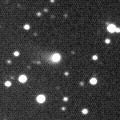
|
It is expected to be bright as 10 mag in early 2006. It was 16.4 mag at the discovery in March (Mar. 12, R. H. McNaught). Then it brightened well as expected, and became visible visually as 12.9 mag on July 30 (David A. J. Seargent). Now it is 12.2 mag (Aug. 3, Juan Jose Gonzalez). In the Southern Hemisphere, it keeps locating high until November while the comet is getting brighter gradually. In the Northern Hemisphere, it keeps locating very low around 15 degree high until September.
Date(TT) R.A. (2000) Decl. Delta r Elong. m1 Best Time(A, h)
Aug. 20 19 39.96 -39 14.0 2.017 2.864 139 12.5 21:44 ( 0, 86)
Aug. 27 19 34.37 -38 36.7 2.007 2.795 132 12.4 21:11 ( 0, 86)
|

|
It was fantastic, so bright as 3.5 mag, so large as 30 arcmin, locating high overhead at its best time in early January. Then it has been getting fainter and smaller gradually, and 11.9 mag on Aug. 5 (Reinder J. Bouma). The diameter is small now, about 2 arcmin, and very diffused. In the Northern Hemisphere, it keeps observable in good condition for a long time while the comet is bright enough visible visually until October when it becomes faint as 14 mag. Although it has been observable in the Northern Hemisphere for about one year since its discovery, now it is getting lower and lower. It will be lower than 20 degree at 13.5 mag in late September.
Date(TT) R.A. (2000) Decl. Delta r Elong. m1 Best Time(A, h)
Aug. 20 14 9.90 17 0.2 3.450 3.091 61 12.6 18:56 (137, 25)
Aug. 27 14 17.69 15 18.2 3.594 3.166 57 12.8 19:01 (130, 23)
|
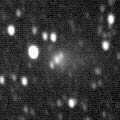
|
Although it was only 19 mag in January, it brightened as expected, and became visible visually at 12.5 mag on June 7 (John Drummond). Now it is 12.2 mag (Aug. 2, Juan Jose Gonzalez). The condition is good in the Southern Hemisphere. However, it locates very low in the Northern Hemisphere. Although it is getting higher gradually, it will be fainter than 13.5 mag when the altitude becomes higher than 30 degree.
Date(TT) R.A. (2000) Decl. Delta r Elong. m1 Best Time(A, h)
Aug. 20 17 13.08 -28 18.9 0.890 1.583 112 12.7 19:19 (180, 83)
Aug. 27 17 30.05 -27 14.3 0.939 1.593 109 12.9 19:08 (180, 82)
|

|
It was recorded as an asteroid at the discovery in 2002. It returned again now, and the faint tail was detected and it revealed to be a comet in fact. It passed very close by the earth in early August, and the central nucleus was visible visually at 14.9 mag (Aug. 2, Edwin van Dijk). Extremely faint and diffuse coma can be visible with a clear sky. The total brightness is so bright as 12.5 mag (Aug. 5, Michael Jager). It will be too close to the sun to observe after this, but it will appear in the morning sky again in mid September. Then it will be higher gradually, however, will fade out rapidly. Although the stellar nucleus was very bright in early August, it moves between the sun and the earth after this and the nucleus will be too faint to observe. Only the faint coma will be observable. In September when it appears again in the morning sky, the total brightness is expected to be 13-14 mag, however, the nuclear brightness will be so faint as 18 mag. Therefore it will be hard to observe.
Date(TT) R.A. (2000) Decl. Delta r Elong. m1 Best Time(A, h)
Aug. 20 9 49.43 33 42.2 0.221 0.810 21 12.8 5:10 (246,-27)
Aug. 27 9 20.14 23 8.6 0.302 0.733 19 13.1 5:01 (250,-13)
|
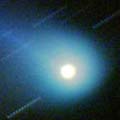
|
The brightness evolution had been slower than a typical comet since its discovery until the perihelion passage in early April. Although it had been observable only until March in the Northern Hemisphere, it has been observed continuously in the Southern Hemisphere, and it kept bright as 8 mag from mid March to mid May. It had been low until early July even in the Southern Hemisphere. The comet has faded out rapidly while locating low. No observations have been reported since mid May. However, it was observed on Aug. 1, when it was still bright as expected, 13.0 mag (Michael Mattiazzo). It is not observable in the Northern Hemisphere until late September when it appears very low sky at dawn as 14 mag.
Date(TT) R.A. (2000) Decl. Delta r Elong. m1 Best Time(A, h)
Aug. 20 7 20.96 -34 48.9 2.719 2.381 60 12.8 5:10 (290, 38)
Aug. 27 7 26.26 -35 29.5 2.781 2.469 61 13.0 5:01 (289, 41)
|

|
It had been always brighter than 13 mag and visible visually all through the season in 2004. On the other hand, it is very inactive now in 2005. Ater observed as 14.2 mag on May 31 (Ken-ichi Kadota), it has been so faint as 16 mag from June to early August. It is stellar by CCD obseravtions, but the extremely faint coma seems also visible. Visually, it has been too faint to see, fainter than 13.3 mag on July 15 (Reinder J. Bouma) and fainter than 12.9 mag on Aug. 6 (Seiichi Yoshdia).
Date(TT) R.A. (2000) Decl. Delta r Elong. m1 Best Time(A, h)
Aug. 20 2 21.22 24 27.3 5.399 5.756 105 13.4 4:28 (180, 31)
Aug. 27 2 21.34 24 41.2 5.298 5.757 112 13.3 4:01 (180, 30)
|
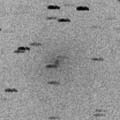
|
New periodic comet with a very short period of 4.4 years. It passed very close by the earth in June, about 0.1 AU. Although it was so faint as 17.5 mag in early May, it brightened rapidly, 13.5 mag on June 6, 12.0-12.5 mag on June 12 (Michael Jager), and became visible visually as bright as 10.3 mag on June 25 (Juan Jose Gonzalez). Because it was so close to the earth, it had a very large and faint coma with a diameter of 4-8 arcmin. Surprisingly, it was detected on survey images on June 24 as a very bright and large object, 8-9 mag with a diameter of 20 arcmin (Terry Lovejoy). It appeared again in the morning sky, and it was bright as 11.5 mag on Aug. 2, as bright as this ephemeris (Michael Jager). It was also observed visually on Aug. 5 as 10.5 mag, but extremely diffuse (Seiichi Yoshida). It will fade out rapidly after this.
Date(TT) R.A. (2000) Decl. Delta r Elong. m1 Best Time(A, h)
Aug. 20 5 38.80 13 1.8 0.491 0.900 62 13.4 5:10 (225, 29)
Aug. 27 5 45.91 13 23.2 0.541 0.947 67 14.1 5:01 (222, 31)
|

|
It was bright as 7.5 mag in early January, easy to see with binoculars. However, it faded and got diffused rapidly in the evening sky after that. It faded to 10.7 mag on Mar. 15 visually (Alexandre Amorim), and 11.5 mag on Apr. 4 by CCD observation (Mitsunori Tsumura), then it became unobservable. Now it appears in the morning sky after the long blank. It was 13.6 mag on Aug. 4, as bright as expected (Ken-ichi Kadota). It can be brighter than 13 mag visually still now. Because it is distant from the sun, the fading is slow. It will be higher than 40 degree in September, when it will keep similar brightness.
Date(TT) R.A. (2000) Decl. Delta r Elong. m1 Best Time(A, h)
Aug. 20 4 30.61 -6 6.8 4.254 4.254 83 13.8 5:10 (220, 55)
Aug. 27 4 28.62 -6 41.2 4.211 4.326 89 13.9 5:01 (212, 58)
|
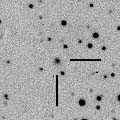
|
It brightened from 18 to 15 mag during one year from the end of 2003 to early 2005. The brightness evolution was much faster than that of a typical comet. After that, it kept 15-15.5 mag until May. Although it had been too low for a while, it is getting higher again now. It can be 13 mag and may be visible visually in next winter.
Date(TT) R.A. (2000) Decl. Delta r Elong. m1 Best Time(A, h)
Aug. 20 8 21.50 44 53.8 6.240 5.481 38 14.6 5:10 (227,-17)
Aug. 27 8 30.62 44 50.6 6.170 5.465 42 14.6 5:01 (226,-16)
|

|
It was 16.8 mag at the discovery in May (May 20, R. H. McNaught). Then it brightened rapidly, and reached to 15 mag in late July by CCD observations. Michael Jager reported it was very bright as about 14 mag on Aug. 2. It was also visible visually as 13.9 mag (Aug. 5, Seiichi Yoshida). Because it moves in the northern sky, it keeps locating high for a long time in the Northern Hemisphere. It will be visible visually at 14 mag until November.
Date(TT) R.A. (2000) Decl. Delta r Elong. m1 Best Time(A, h)
Aug. 20 3 21.40 26 36.8 1.086 1.512 92 14.9 5:10 (185, 28)
Aug. 27 3 37.55 29 32.0 1.055 1.518 94 14.8 5:01 (184, 25)
|
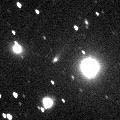
|
Although the CCD nuclear magnitude was reported so faint as 16.5-17 mag, it is actually bright as 15.7 mag (June 26, Giovanni Sostero). Sharply and strongly condensed with a narrow long tail. It will be 15 mag both in 2005 summer and 2006 summer. It moves southwards, so the condition in the Northern Hemisphere is better in 2005. It was visible visually as 13.8 mag (July 28, Seiichi Yoshida).
Date(TT) R.A. (2000) Decl. Delta r Elong. m1 Best Time(A, h)
Aug. 20 16 28.49 42 46.7 3.698 3.786 87 15.1 18:56 (176, 12)
Aug. 27 16 30.70 40 5.1 3.724 3.773 85 15.1 19:01 (169, 14)
|

|
Although it was faint as 16.4 mag in January, it brightened to 14.6 mag in May when it became at opposition (Jan. 26 and May 31, Ken-ichi Kadota). It was also visible visually as 14.3 mag (May 7, Juan Jose Gonzalez). Then it was predicted to be slightly fainter, however, it brightened furthermore visually, 13.8 mag on July 10 (Reinder J. Bouma). It is already declining in the evening sky, but it will be visible around 13.5-14 mag, brighter than this ephemeris by 1 mag. But on the other hand, the CCD nuclear magnitude has been reported fainter, 15.5 mag in July.
Date(TT) R.A. (2000) Decl. Delta r Elong. m1 Best Time(A, h)
Aug. 20 15 36.99 -22 14.2 2.923 3.097 90 15.1 18:56 (123, 69)
Aug. 27 15 43.00 -22 41.2 3.011 3.090 84 15.2 19:01 (112, 65)
|
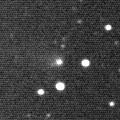
|
New bright periodic comet discovered in 2004 spring. It keeps brighter than 19 mag even around the aphelion. It had been bright at 15.0-15.5 mag from spring to summer in 2004. It has been also bright at 14.5-15.0 mag from spring to summer in 2005. It must be around 13.5 mag visually, but no visual observations have been reported yet. It locates very low, around 20 degree high, in the Northern Hemisphere. So it will be hard to see it visually.
Date(TT) R.A. (2000) Decl. Delta r Elong. m1 Best Time(A, h)
Aug. 20 19 50.90 -37 9.2 2.243 3.108 142 15.2 21:55 ( 0, 88)
Aug. 27 19 48.42 -37 10.5 2.315 3.122 136 15.3 21:25 ( 0, 88)
|

|
It is getting higher in the morning sky, however, it will be fading after this. It was 13.6 mag on May 12, as bright as expected (Michael Mattiazzo). Although it is already high enough to observe, only few observations have been reported recently.
Date(TT) R.A. (2000) Decl. Delta r Elong. m1 Best Time(A, h)
Aug. 20 4 53.50 11 27.3 2.331 2.270 73 15.4 5:10 (214, 37)
Aug. 27 5 1.48 11 23.6 2.290 2.313 78 15.6 5:01 (211, 38)
|

|
Recovery of a peculiar asteroid 2004 FS101 discovered in 2004 spring. Although it was 18 mag in mid January, it brightened to 16-16.5 mag in mid May. The brightness evolution was rather faster than that of a typical comet. It will be 14.5 mag around 2006 January, although it will be rather low for the northern observers. It keeps observable at 15-16 mag for a long time from 2005 spring to the end of 2006. Because it moves in the northern sky, it keeps observable for a long time in the Northern Hemisphere. It was not visible visually, fainter than 14.0 mag on Aug. 5 (Seiichi Yoshida).
Date(TT) R.A. (2000) Decl. Delta r Elong. m1 Best Time(A, h)
Aug. 20 13 31.17 47 34.1 4.126 3.667 56 15.7 18:56 (149, -4)
Aug. 27 13 37.94 47 18.3 4.114 3.635 55 15.7 19:01 (145, -7)
|
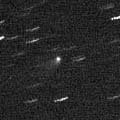
|
Although it was faint as 16.5 mag in early February, it was observed visually at 15.0 mag in May when it became at opposition (May 7, Shigeki Murakami). Then it was predicted to be slightly fainter, however, it actually brightened furthermore by 1 mag, 14.1 mag on June 13 by CCD observation (Yusuke Ezaki). It was 14.3 mag visually on July 10 (Edwin van Dijk). It is already declining in the evening sky, but it will be visible around 14.5 mag, brighter than this ephemeris by 1 mag. But on the other hand, the CCD nuclear magnitude has been reported fainter on and on, 16 mag in June and 16.5 mag in July.
Date(TT) R.A. (2000) Decl. Delta r Elong. m1 Best Time(A, h)
Aug. 20 13 53.08 11 54.2 3.860 3.426 57 15.8 18:56 (129, 27)
Aug. 27 13 51.36 11 11.7 3.976 3.435 51 15.9 19:01 (122, 22)
|

|
It was observed as 17.0 mag on July 10, as bright as expected. It will be 15.5 mag from September to December. It is already high in the morning sky. It was 15.7 mag on Aug. 5, brighter than this ephemeris (Yuji Ohshima).
Date(TT) R.A. (2000) Decl. Delta r Elong. m1 Best Time(A, h)
Aug. 20 0 32.36 -2 2.7 1.730 2.589 140 16.1 2:39 (180, 57)
Aug. 27 0 32.51 -2 25.9 1.659 2.565 146 16.0 2:12 (180, 57)
|
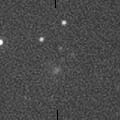
|
It was reported as 16.4 mag on Aug. 5 (Yuji Ohshima), brighter than this ephemeris. It will be observable at 16.5 mag in good condition until October.
Date(TT) R.A. (2000) Decl. Delta r Elong. m1 Best Time(A, h)
Aug. 20 2 38.94 -0 35.6 0.986 1.628 109 16.6 4:45 (180, 56)
Aug. 27 2 56.26 -2 28.1 0.957 1.628 111 16.5 4:35 (180, 57)
|

|
Although it had been locating low for a while, now it is getting higher again. Fading slowly.
Date(TT) R.A. (2000) Decl. Delta r Elong. m1 Best Time(A, h)
Aug. 20 1 57.26 63 41.6 5.650 5.761 91 17.1 4:04 (180, -9)
Aug. 27 1 51.54 64 1.8 5.631 5.826 96 17.2 3:31 (180, -9)
|
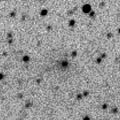
|
It will be at opposition again between autumn and winter, and observable at 17.5 mag locating high.
Date(TT) R.A. (2000) Decl. Delta r Elong. m1 Best Time(A, h)
Aug. 20 4 11.02 17 52.0 4.388 4.379 82 17.7 5:10 (200, 35)
Aug. 27 4 13.80 18 1.3 4.292 4.391 88 17.7 5:01 (195, 36)
|
|
![]()
 C/2005 N5 ( Catalina )
C/2005 N5 ( Catalina ) C/2001 Q4 ( NEAT )
C/2001 Q4 ( NEAT ) 65P/Gunn
65P/Gunn![]()
























